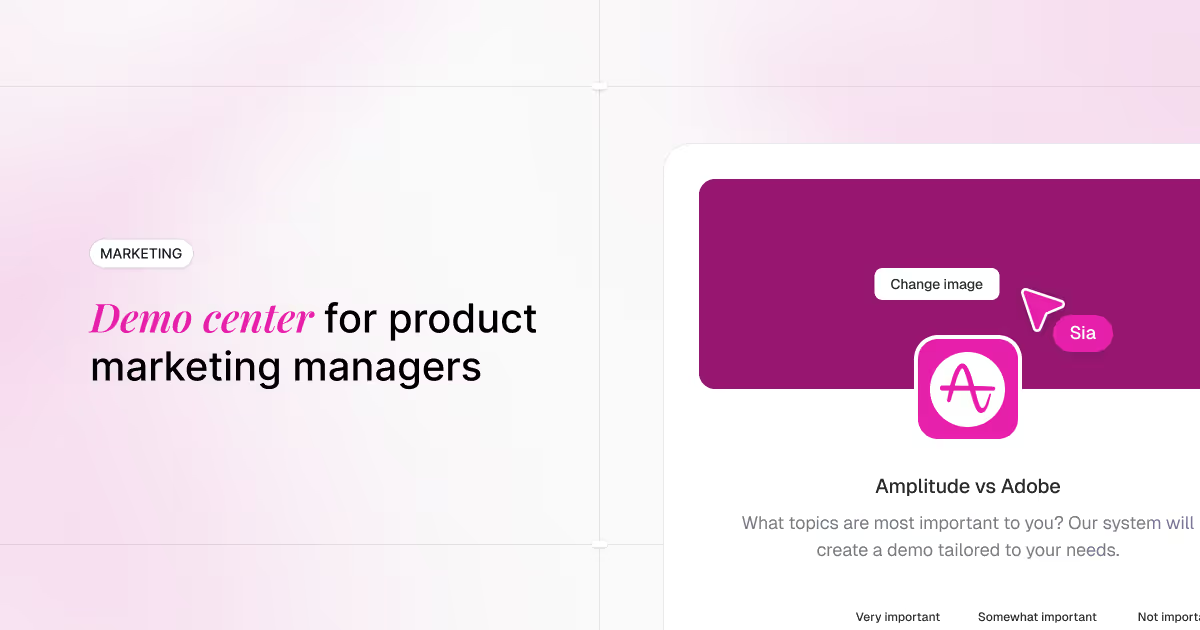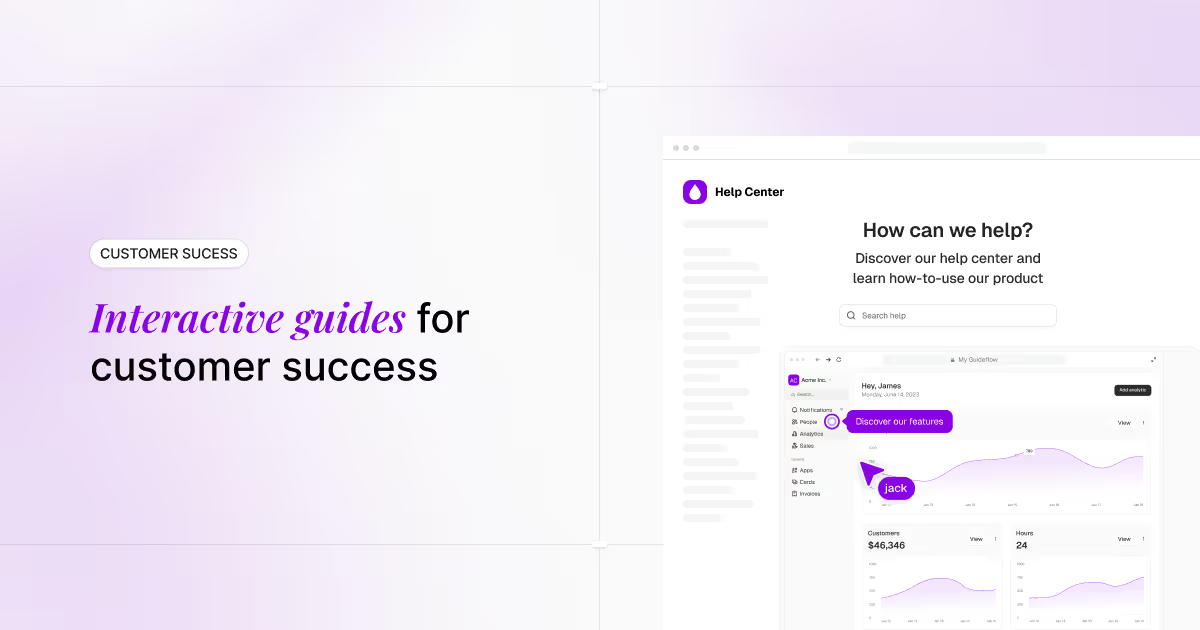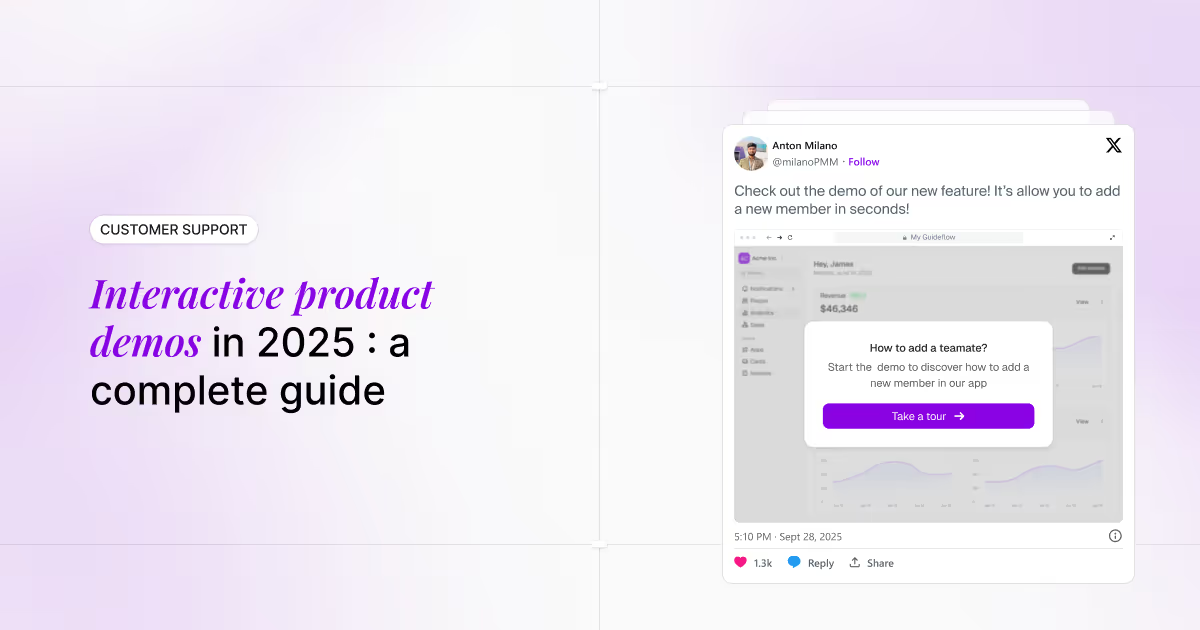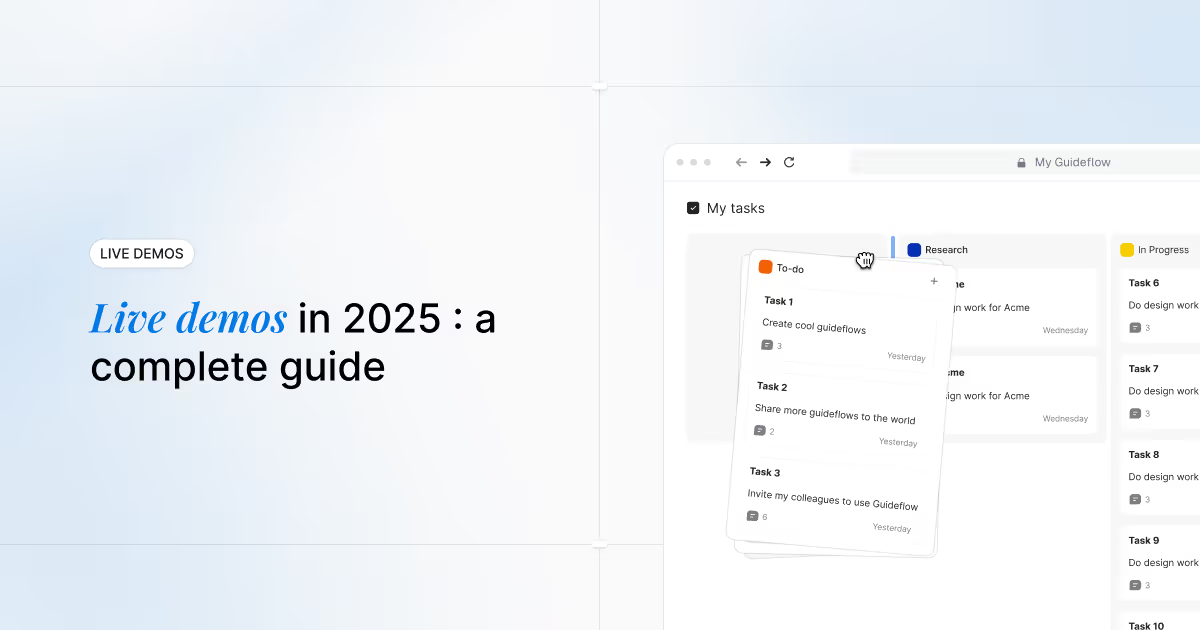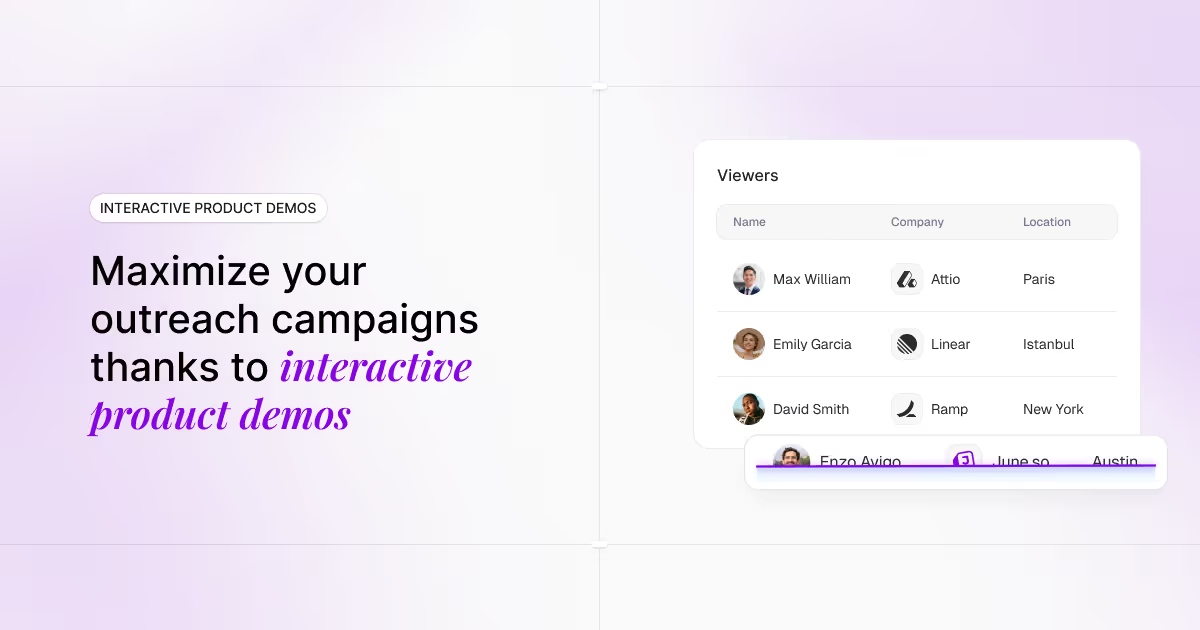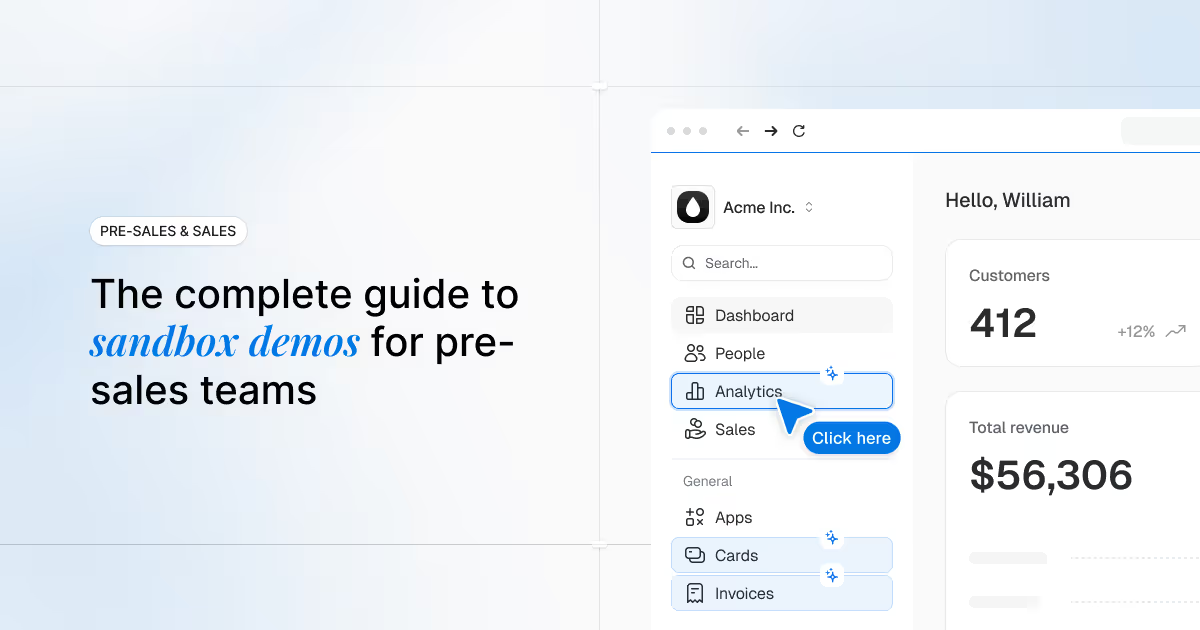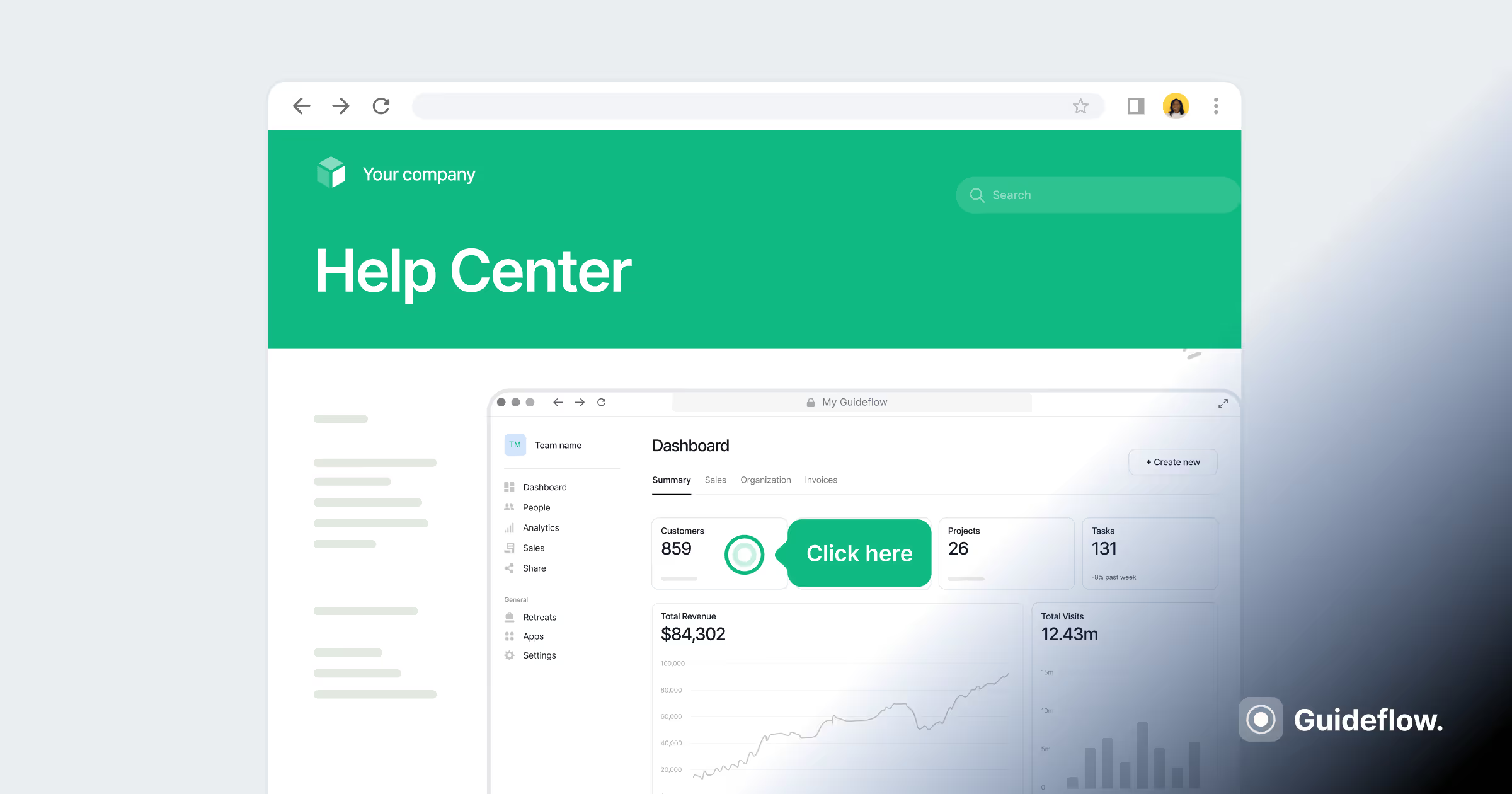Organizations implementing demo centers report 2-3x higher conversion rates on landing pages compared to static content, 73% higher engagement versus generic marketing materials, and 50% higher click-through rates than traditional static marketing approaches.
These impressive results address critical challenges that product marketing managers face today. Modern buyers expect immediate, personalized experiences, while generic marketing approaches fail to resonate with different personas. Additionally, limited buyer behavior insights make campaign optimization nearly impossible. These statistics clearly demonstrate how demo centers directly address these issues.
Demo centers offer a strategic solution by functioning as interactive marketing hubs that enable personalized buyer journeys while capturing detailed engagement analytics. They transform how product marketing teams deploy and optimize campaigns across every channel, from landing pages and email campaigns to social media and content marketing. The implementation approach integrates seamlessly with existing marketing automation tools while providing practical frameworks to achieve these conversion improvements immediately.
What is a demo center?
A demo center is an interactive digital platform that showcases your product's capabilities through self-guided experiences, personalized journeys, and educational content designed specifically for marketing campaign optimization and buyer engagement. Unlike basic product videos or static landing pages, demo centers provide adaptive marketing experiences that guide prospects through specific use cases, feature explorations, and qualification processes while capturing detailed behavioral analytics for campaign optimization.
At its core, a demo center functions as an interactive marketing hub where prospects can explore your solution's capabilities through personalized pathways. Consider a B2B software company where visitors can experience tailored product demonstrations based on their industry, company size, or specific use case, while marketing teams gather detailed insights about engagement patterns, feature interests, and buying intent signals. This approach enables marketing campaigns to deliver personalized experiences at scale while generating qualification data for sales teams.
Key components of a marketing-focused demo center include
- Adaptive buyer journeys that personalize content based on visitor data, demographics, and behavioral signal
- Multi-channel deployment capabilities for consistent experiences across email campaigns, social media, ads, and landing pages
- Real-time engagement analytics that track visitor behavior, content preferences, and conversion pathways
- Lead qualification automation that scores prospects based on engagement depth and demonstrated interest areas
- Interactive content libraries including product tours, feature showcases, and use case demonstrations
- Campaign integration tools that enable seamless deployment across marketing automation platforms
- Multi-stakeholder tracking that identifies and follows all decision-makers from enterprise accounts
Modern platforms like Guideflow allow marketing teams to build compelling interactive campaign experiences that integrate seamlessly with existing marketing automation tools and CRM systems. These solutions provide detailed analytics on campaign performance, automatic lead scoring, and comprehensive insights into buyer journey progression and content effectiveness.
The centralized approach solves fundamental marketing scalability challenges by enabling personalized buyer experiences at scale while preserving marketing team resources for strategic campaign development, competitive positioning, and high-value account-based marketing initiatives.
The product marketing scaling challenge
Product marketing teams encounter campaign inefficiencies that compound into significant conversion losses. Low landing page conversion rates plague even high-traffic campaigns as generic experiences fail to engage diverse buyer personas, while complex product features remain difficult to explain through traditional marketing content and static demonstrations. Engagement drops significantly when prospects encounter lengthy forms or generic product information that doesn't address their specific use cases or industry requirements.
Content distribution challenges compound these inefficiencies as marketing teams struggle to maintain consistency across multiple channels and touchpoints. Scattered marketing assets across email campaigns, social media, landing pages, and content marketing create fragmented buyer experiences that reduce message impact and conversion effectiveness. Channel inconsistencies in messaging, branding, and user experience damage campaign performance, while measurement difficulties across touchpoints prevent accurate attribution and optimization efforts.
Buyer experience issues create hidden conversion losses throughout marketing campaigns and funnel progression. Generic marketing experiences fail to resonate with different buyer personas, segments, and stakeholder types, leading to decreased engagement and premature prospect departure. Poor lead qualification from marketing campaigns results in misaligned sales handoffs and reduced conversion rates, while competitive disadvantages emerge when prospects encounter more engaging and interactive approaches from competing solutions.
Strategic marketing challenges limit overall campaign effectiveness as teams cannot efficiently balance personalization demands with scaling requirements. Campaign personalization efforts consume excessive resources while delivering limited impact across diverse prospect segments. Analytics limitations prevent deep understanding of buyer behavior and content effectiveness, while funnel optimization efforts lack granular insights into conversion barriers and engagement patterns that drive successful buyer progression.
How demo centers solve product marketing challenges
- Increase landing page conversion rates dramatically by replacing static content with interactive experiences that engage visitors immediately and guide them through personalized product exploration based on their specific interests and requirements.
- Transform static content into engaging interactive experiences across all marketing channels, converting traditional whitepapers, blog posts, and email content into dynamic demonstrations that maintain prospect attention and drive deeper engagement.
- Capture detailed buyer intent and behavior analytics through comprehensive tracking of prospect interactions, feature interests, time spent on different content sections, and engagement patterns that inform future campaign optimization and personalization efforts.
- Enable personalized marketing campaigns at scale by automatically adapting demo content, messaging, and pathways based on visitor data, demographic information, and behavioral signals without requiring manual customization for each prospect segment.
- Streamline multi-channel campaign deployment by providing consistent interactive experiences that can be embedded across email campaigns, social media, landing pages, and advertising while maintaining brand consistency and message alignment.
- Improve lead quality and qualification automatically through behavioral scoring that identifies high-intent prospects based on engagement depth, feature exploration patterns, and time investment in specific product capabilities relevant to their potential use cases.
- Differentiate from competitors using traditional marketing approaches by providing interactive experiences that stand out in crowded markets where most companies rely on static content, generic demos, and one-size-fits-all marketing campaigns.
- Centralize scattered marketing assets into cohesive buyer journeys that guide prospects through logical progression from awareness to consideration while eliminating the fragmented experience of multiple disconnected marketing touchpoints.
- Accelerate marketing funnel velocity and progression by removing friction points, providing immediate access to relevant product information, and enabling prospects to self-qualify and advance through buying stages at their preferred pace.
- Support multi-stakeholder enterprise marketing campaigns by providing different content pathways for technical evaluators, business decision-makers, and financial stakeholders while tracking engagement across the entire buying committee.
- Enable data-driven campaign optimization and A/B testing through detailed analytics on content performance, conversion pathways, and engagement patterns that inform strategic marketing decisions and tactical campaign improvements.
Demo centers provide comprehensive marketing attribution insights that connect prospect engagement to specific campaigns, content pieces, and marketing touchpoints. Integration with CRM systems and marketing automation platforms ensures behavioral data flows automatically into lead scoring models, campaign optimization workflows, and sales intelligence systems that enhance follow-up effectiveness and conversion rates.
Real-world product marketing use cases
Use case 1: Landing page conversion optimization
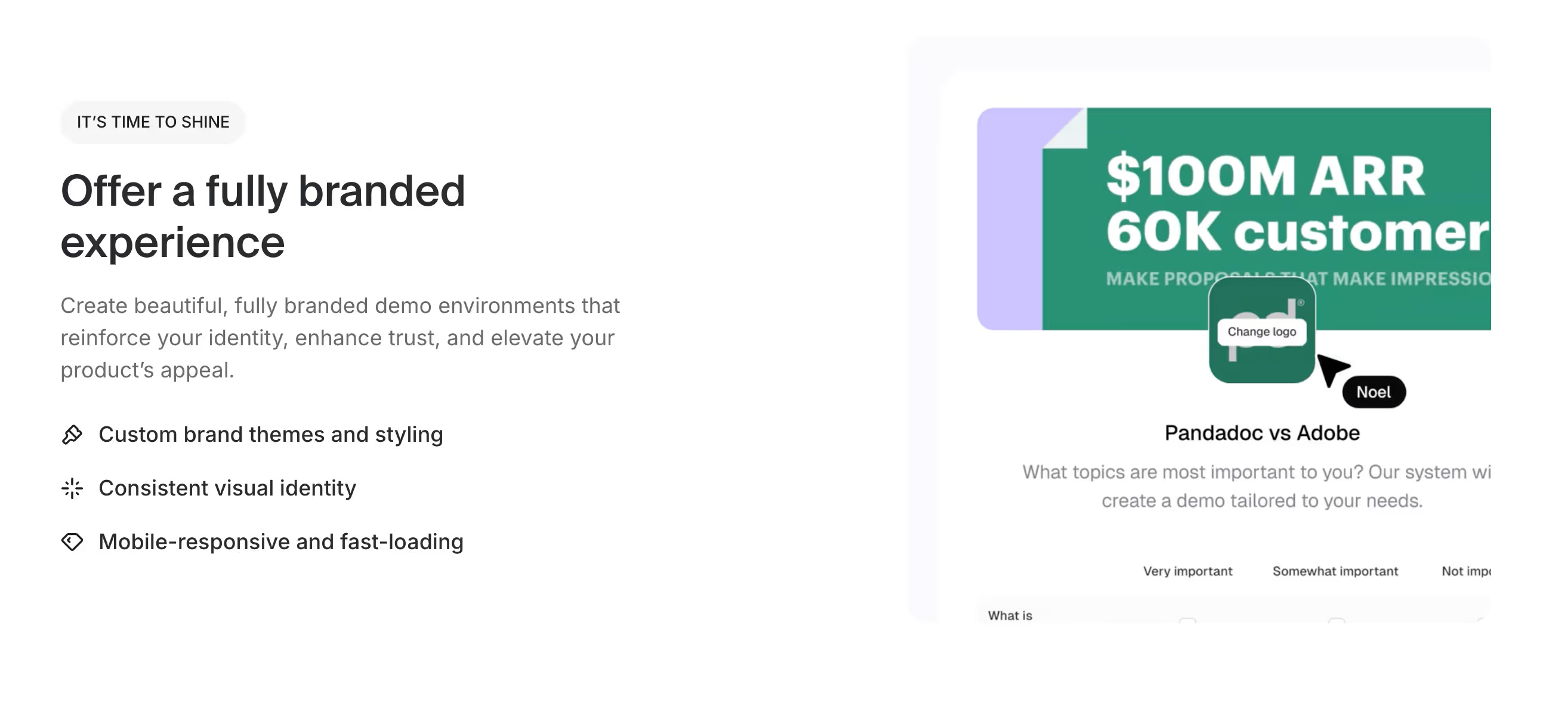
Product marketing teams consistently struggle with low conversion rates on key landing pages despite significant traffic from paid advertising, content marketing, and organic search efforts. Traditional static landing pages fail to engage diverse visitor segments while generic calls-to-action don't resonate with different buyer personas, industries, or company sizes. Prospects bounce quickly when they cannot immediately see relevant value propositions or understand how complex products address their specific challenges and requirements.
Demo centers solve this challenge through interactive landing page experiences that adapt content based on visitor characteristics and engagement patterns. Personalized product demonstrations guide visitors through relevant use cases while built-in qualification tools capture specific requirements, pain points, and buying timeline information. Adaptive pathways ensure different buyer personas encounter tailored messaging and feature showcases that resonate with their roles and responsibilities.
Benefits
- Increase landing page conversion rates by 2-3x compared to static content approaches
- Reduce bounce rates significantly through immediate interactive engagement and personalization
- Generate higher-quality leads through behavioral qualification and intent signal capture
- Improve campaign ROI by maximizing conversion value from existing traffic sources
- Enable rapid A/B testing of different interactive experiences and conversion pathways
When to use
- High-traffic landing pages from paid advertising campaigns requiring conversion optimization
- Product launch landing pages where complex features need interactive demonstration
- Account-based marketing campaigns targeting specific enterprise prospects
- Competitive differentiation scenarios where interactive experiences provide advantages
- Multi-persona campaigns requiring different content pathways and messaging approaches
Use case 2: Multi-channel campaign enhancement
Marketing teams face significant challenges maintaining consistent messaging and engagement across email campaigns, social media, paid advertising, and content marketing initiatives. Traditional approaches result in fragmented buyer experiences where prospects encounter different messaging, varying quality levels, and disconnected content that reduces overall campaign effectiveness. Channel-specific limitations prevent comprehensive engagement tracking and attribution analysis across the complete buyer journey.
Interactive demo experiences provide unified campaign foundations that can be deployed consistently across all marketing channels while maintaining brand coherence and message alignment. Demo centers enable email campaigns with embedded interactive content, social media posts featuring engaging product demonstrations, and advertising campaigns that drive prospects to personalized landing experiences rather than generic product pages.
Benefits
- Maintain consistent buyer experiences across all marketing touchpoints and channels
- Increase email campaign click-through rates and engagement metrics significantly
- Improve social media engagement and sharing rates through interactive content
- Enhance paid advertising performance with higher-converting destination experiences
- Enable comprehensive cross-channel attribution and buyer journey tracking
When to use
- Integrated marketing campaigns requiring consistent messaging across multiple channels
- Product launch initiatives coordinating email, social, advertising, and content marketing
- Account-based marketing programs targeting enterprise prospects through multiple touchpoints
- Competitive positioning campaigns where message consistency provides strategic advantages
- Attribution analysis projects requiring detailed cross-channel engagement tracking
Use case 3: Content marketing and thought leadership
Content marketing strategies often struggle with engagement limitations inherent in static formats like blog posts, whitepapers, and educational resources. Traditional content approaches result in declining engagement rates as prospects consume information passively without opportunities for interaction or hands-on exploration. Complex product features and technical capabilities remain difficult to communicate effectively through written content alone, limiting educational impact and lead generation potential.
Interactive content experiences transform traditional marketing materials into engaging demonstrations that maintain prospect attention while providing educational value. Demo centers enable blog posts with embedded product tours, whitepapers featuring interactive case studies, and educational resources that combine learning objectives with hands-on product exploration. This approach maintains thought leadership positioning while generating qualified leads through content engagement.
Benefits
- Transform static content into engaging interactive experiences that maintain prospect attention
- Increase content engagement metrics including time-on-page and interaction rates
- Generate qualified leads directly from educational content without intrusive lead capture forms
- Enhance thought leadership positioning through innovative content presentation approaches
- Improve content ROI by converting educational materials into lead generation assets
When to use
- Complex product categories requiring educational content to build market awareness
- Thought leadership initiatives where interactive approaches differentiate from competitors• Content marketing programs focused on lead generation rather than pure education• Technical product marketing where hands-on demonstration enhances understanding• SEO-focused content strategies where engagement metrics impact search rankings
Use case 5: Product launch and feature marketing
Product marketing teams face coordination challenges when launching new features or products across multiple marketing channels while ensuring consistent messaging and effective adoption communication.
- Landing page optimization requires interactive demonstrations that showcase new capabilities immediately upon visitor arrival, replacing static feature lists with hands-on exploration opportunities.
- Email campaigns need engaging content that breaks through inbox clutter while providing immediate access to new feature experiences rather than requiring additional clicks to external demonstration environments.
- Ads campaigns must differentiate from competitors through interactive elements that capture attention and demonstrate unique value propositions within advertising formats and landing page experiences.
- Social media marketing demands shareable interactive content that generates engagement and extends reach while providing meaningful product experiences within social platform constraints.
- Content marketing initiatives require transformation of feature announcements into educational interactive experiences that combine thought leadership with hands-on demonstration.
- Changelog communications need to move beyond simple feature lists toward interactive showcases that help existing customers understand and adopt new capabilities through guided exploration.
- Review platform enhancement involves combining customer testimonials with relevant product demonstrations that provide social proof alongside interactive validation of claimed benefits and capabilities.
The volume and complexity of coordinating feature marketing across these diverse channels creates resource allocation challenges for product marketing teams who cannot efficiently customize content for each touchpoint while maintaining message consistency and campaign effectiveness. Traditional approaches require separate content creation for each channel while limiting reusability and cross-campaign optimization opportunities.
Demo centers address these challenges through coordinated launch experiences that can be adapted across all marketing channels while maintaining consistent product positioning and feature messaging. Interactive launch content provides centralized assets that support email campaigns, social sharing, advertising destinations, and content marketing initiatives while generating comprehensive analytics across all deployment scenarios.
Benefits
- Coordinate consistent product launch messaging across all marketing channels efficiently
- Accelerate feature adoption through interactive exploration rather than static announcements
- Generate comprehensive launch analytics that track engagement across all marketing touchpoints
- Improve launch ROI by maximizing conversion value from coordinated multi-channel efforts
- Enable rapid iteration and optimization based on real-time engagement feedback
When to use
- Major product launches requiring coordination across multiple marketing teams and channels
- Feature releases where hands-on demonstration significantly improves adoption rates
- Competitive product positioning where interactive differentiation provides strategic advantages
- Enterprise product marketing where multiple stakeholders need different feature perspectives
- Launch campaigns with significant marketing investment requiring optimization and attribution analysis
Implementation for product marketing teams
Step 1: Set up CRM integration
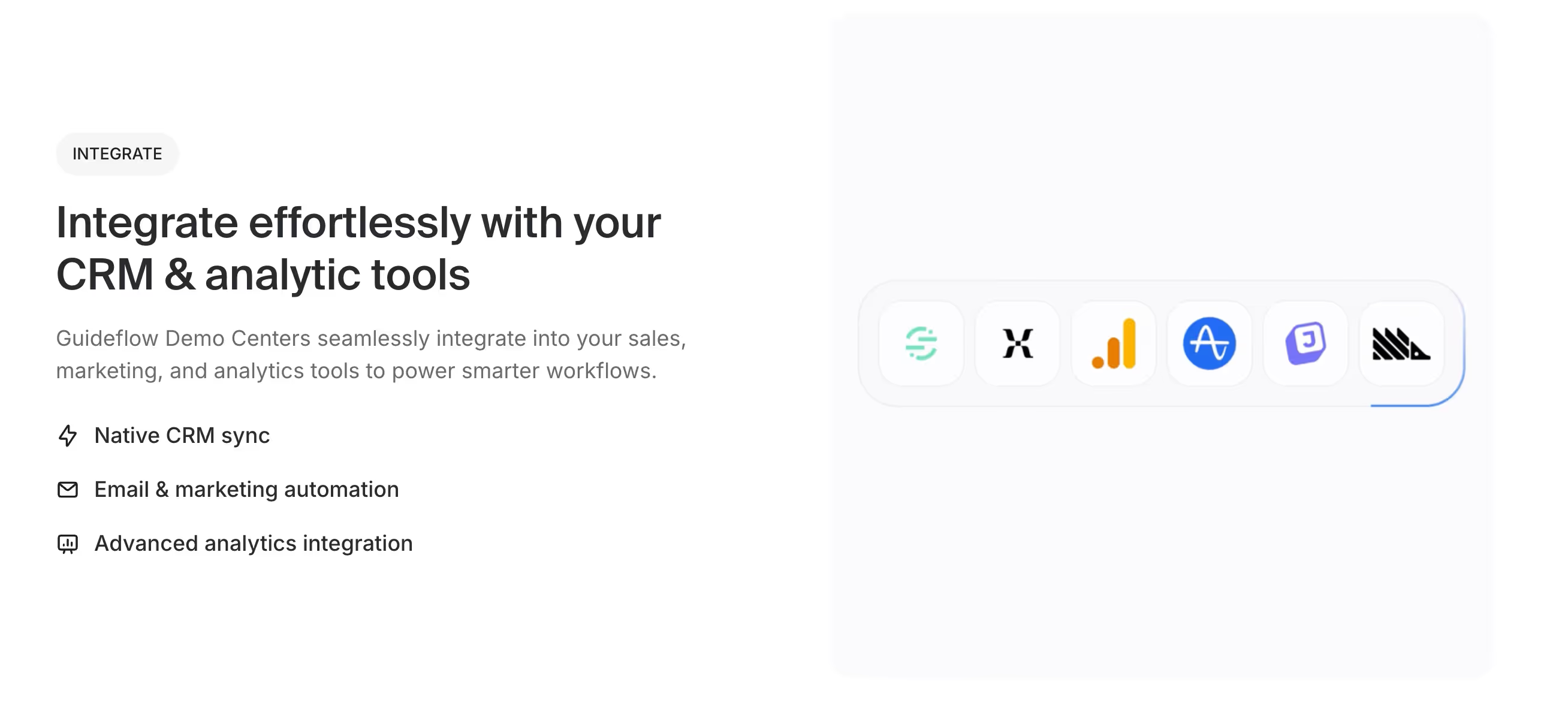
Successful demo center implementation begins with comprehensive CRM integration that ensures seamless data flow between prospect engagement and existing sales workflows. Guideflow provides native connectors that automatically create Salesforce activity records, update HubSpot lead scores, and trigger Pipedrive follow-up sequences based on demo center interactions.
Implementation process
- Connect your CRM through Guideflow's integration dashboard
- Map behavioral data fields to existing contact properties
- Configure automated workflow triggers that notify reps about hot prospects requiring immediate follow-up
Step 2: Organize your workspace
Workspace organization becomes critical for team adoption and efficiency. In Guideflow, sales teams should create dedicated folders for different prospect segments, customer types, or sales processes.
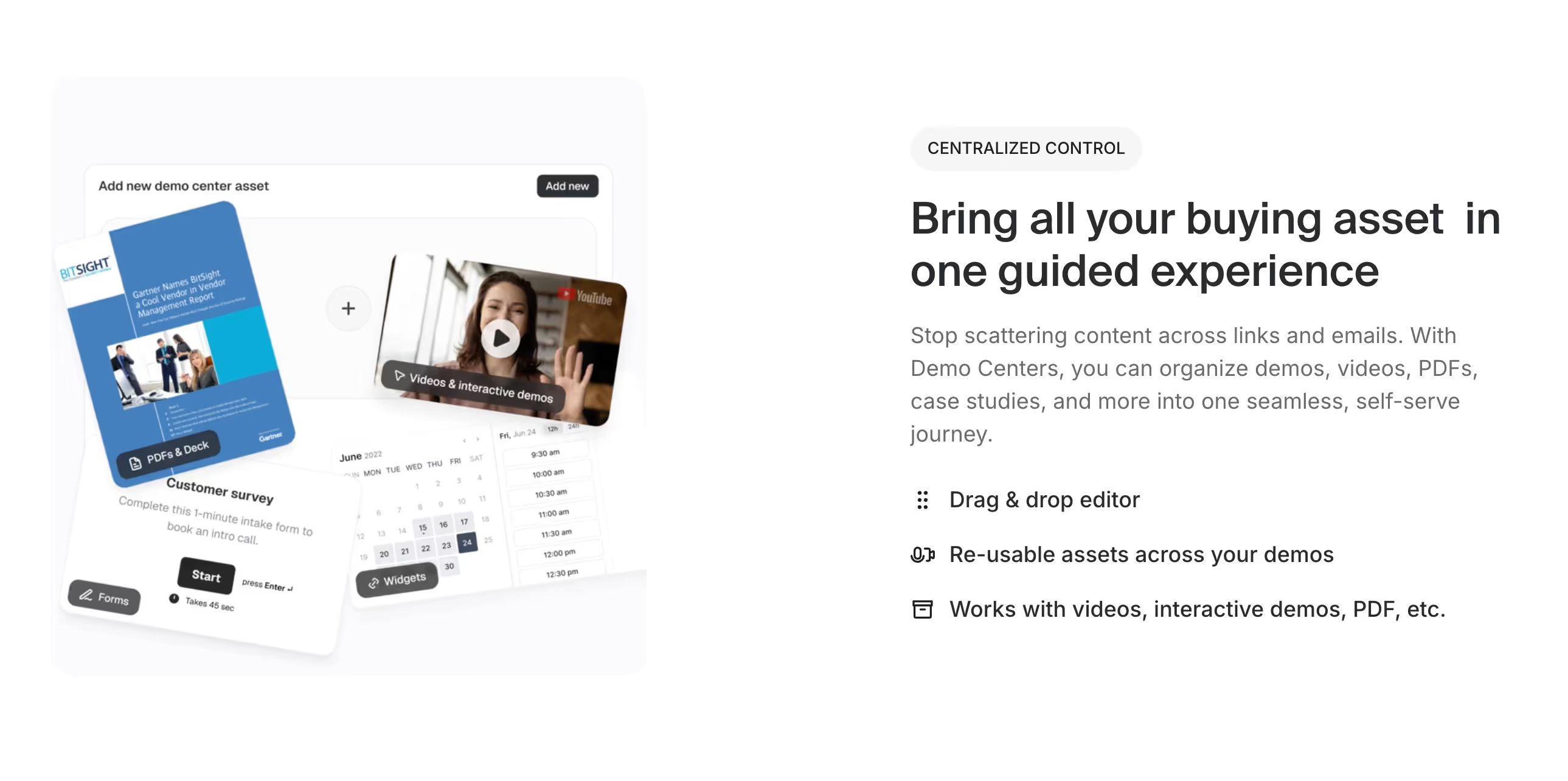
Folder setup process
- Click the "+" button beside "Workspace" on your dashboard
- Create folders by criteria like industry vertical, company size, or buyer persona
- Examples: "Enterprise Prospects," "Mid-Market Opportunities," "SMB Leads"
- Drag and drop folders to organize them as public (all team access), shared (specific team access), or private (individual rep use)
Step 3: Connect outreach tools
Outreach tool connections amplify the power of demo centers by embedding interactive experiences directly into existing sequence workflows. Guideflow integrates with Salesloft, Reply, and Lemlist, allowing BDRs to include demo center links in email templates and call scripts while capturing engagement data.
Integration steps
- Connect your outreach platform through Guideflow's API
- Create template libraries with embedded demo links
- Set up automated follow-up sequences that adjust based on prospect engagement levels and feature interest patterns
Step 4: Establish measurement frameworks
ROI measurement frameworks should focus on metrics that directly impact quota attainment and deal velocity. Guideflow's analytics dashboard provides detailed insights into prospect behavior, engagement depth, and feature exploration patterns that predict deal likelihood and optimize resource allocation.
Key metrics to track
- Demo-to-close conversion rates
- Average sales cycle length
- Pipeline progression velocity
- Demo completion rates
- Stakeholder sharing behavior
- Time spent exploring specific features
Step 5: Plan team adoption strategies
Team adoption strategies require different approaches for BDRs, AEs, and Sales Leaders based on their unique responsibilities and success metrics.
Role-specific implementation
- BDRs: Create organized prospect folders, embed demos in outreach sequences, track engagement for lead qualification
- AEs: Use stakeholder management features, follow-up automation, and analytics for discovery conversations
- Sales Leaders: Leverage team performance dashboards for coaching insights and resource allocation decisions
Step 6: Monitor success metrics
Success metrics and pipeline optimization frameworks should establish baseline measurements before Guideflow implementation and track improvements across key performance indicators.
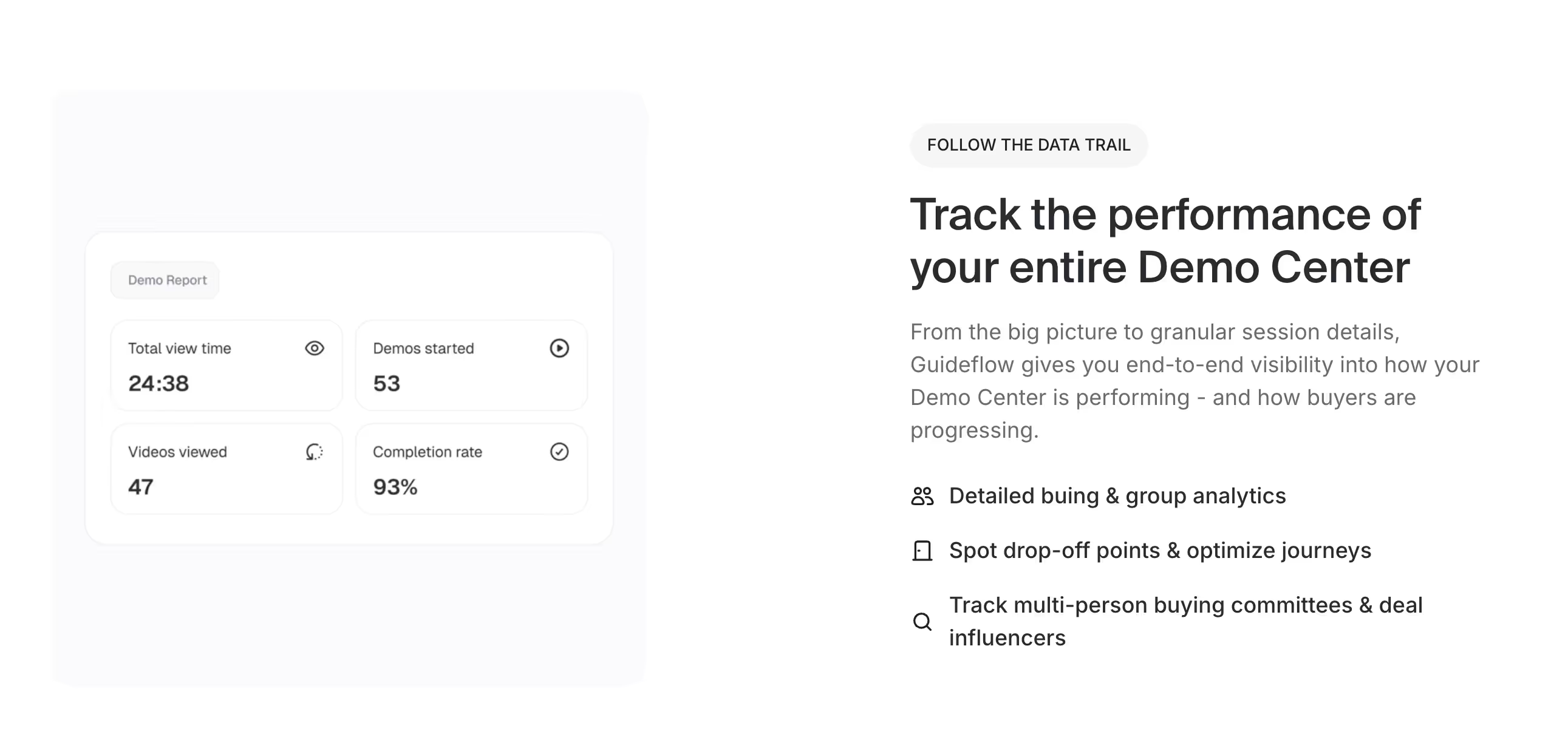
Optimization tracking
- Monitor changes in average deal size, sales cycle length, and win rates
- Track leading indicators like demo engagement rates and follow-up response improvements
- Use Guideflow's reporting features to identify highest-probability opportunities
- Focus team effort on patterns that correlate with successful deals
Conclusion
Demo centers provide product marketing managers with competitive advantages that extend far beyond simple conversion optimization. The strategic value lies in transforming marketing from static content distribution into interactive buyer engagement that scales personalization while generating actionable insights for campaign optimization. Organizations implementing comprehensive demo center strategies report measurable improvements in conversion rates, lead quality, and marketing funnel efficiency.
Research indicates that buyers increasingly expect personalized, interactive experiences before engaging with sales teams, with 2-3x conversion improvement on landing pages representing just the beginning of potential marketing impact. The enhancement approach ensures demo centers amplify existing marketing campaigns rather than requiring complete strategy overhauls while providing immediate conversion and engagement benefits.
Implementation success requires focusing on marketing workflow integration rather than standalone interactive demonstrations. The most effective demo centers become integral components of marketing campaigns that provide buyer insights, improve conversion performance, and enable strategic resource allocation across high-impact marketing initiatives.
Platforms like Guideflow offer marketing-focused demo center solutions with integrated analytics, marketing automation connectivity, and comprehensive campaign deployment capabilities that enhance existing product marketing workflows. Ready to scale your product marketing effectiveness with demo centers? Start building more engaging marketing experiences that drive qualified leads and accelerate buyer journeys through interactive demonstrations that differentiate your product positioning in competitive markets
FAQs
How do demo centers integrate with our existing marketing automation tools?
Demo centers integrate seamlessly with major marketing automation platforms through native APIs and webhooks that sync visitor engagement data, lead scoring information, and behavioral analytics directly into campaign workflows. This integration enables automatic lead nurturing based on demo interactions while maintaining existing campaign structures and measurement frameworks.
Will demo centers replace our current landing page and email marketing strategies?
Demo centers enhance rather than replace existing marketing strategies by adding interactive elements to landing pages and providing engaging content for email campaigns. The technology integrates with current marketing approaches while improving conversion rates and engagement metrics through interactive experiences that complement traditional marketing tactics.
How do we measure ROI from product marketing demo centers?
ROI measurement focuses on conversion rate improvements, lead quality enhancements, and campaign performance optimization across all marketing channels. Key metrics include landing page conversion increases, email engagement improvements, lead qualification accuracy, and overall marketing funnel velocity that demonstrate measurable impact on marketing-generated pipeline and revenue.
How do demo centers help with campaign personalization and segmentation?
Demo centers automatically personalize experiences based on visitor data, behavioral signals, and demographic information while enabling manual segmentation through custom pathways for different buyer personas, industries, or company sizes. This approach scales personalization efforts without requiring individual content creation for each segment.
Can demo centers work across all our marketing channels and touchpoints?
Demo centers provide flexible deployment options that work across email campaigns, social media, landing pages, advertising, and content marketing through embeddable experiences, direct links, and integrated campaign elements. This multi-channel capability ensures consistent buyer experiences while enabling channel-specific optimization and measurement.
How do we track multi-stakeholder engagement in enterprise marketing campaigns?
Demo centers automatically identify and track multiple visitors from the same organization while providing detailed analytics on individual engagement patterns, content preferences, and buying committee dynamics. This capability enables account-based marketing approaches with insights into stakeholder interests and evaluation progress.
What happens when prospects need custom product demonstrations after demo center engagement?
Demo centers provide detailed engagement data that informs sales teams about prospect interests, evaluation progress, and specific feature preferences, enabling more focused and effective custom demonstrations. The qualification information improves sales conversation quality while reducing discovery time requirements.
How do we keep marketing content current with rapid product updates?
Successful demo center implementation requires defined content maintenance processes involving product marketing and product management teams. Modular content architecture enables efficient updates when product capabilities evolve, while version control systems ensure marketing content accuracy across all channels and campaign initiatives.
Can demo centers support complex product positioning and messaging strategies?
Demo centers excel at communicating complex product positioning through interactive experiences that break down sophisticated capabilities into digestible demonstrations. Multiple content pathways enable different positioning approaches for various buyer personas while maintaining consistent core messaging and competitive differentiation.
How do we use demo centers for product launches and feature announcements?
Demo centers provide coordinated launch experiences that can be deployed across email campaigns, social media, advertising, and content marketing while maintaining consistent messaging and feature positioning. Interactive feature showcases generate higher engagement and adoption rates compared to traditional announcement approaches.
Can demo centers help with competitive differentiation and positioning?
Interactive demo experiences provide powerful competitive differentiation by showcasing unique capabilities through hands-on exploration that static competitors cannot match. Demo centers enable direct feature comparisons, benefit demonstrations, and value proposition validation that strengthen competitive positioning in buyer evaluation processes.
Related posts
Learn more about Guideflow, our approach to authentication, and company news.



